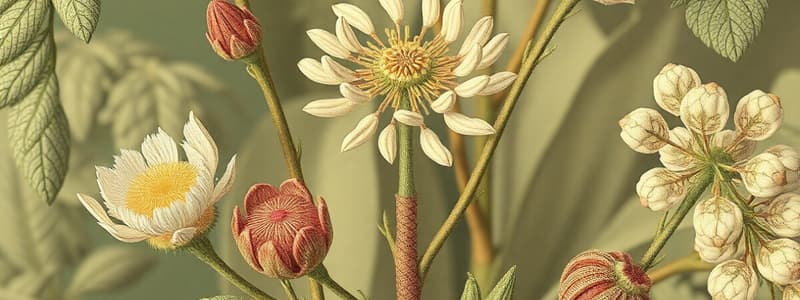Podcast
Questions and Answers
If a plant struggles to transport water and nutrients, which part is most likely malfunctioning?
If a plant struggles to transport water and nutrients, which part is most likely malfunctioning?
- Stems, as they serve as the plant's delivery system for water and nutrients. (correct)
- Flowers, since they need considerable energy to attract pollinators.
- Roots, because they primarily facilitate nutrient absorption from the soil.
- Leaves, because they require a steady supply of water and nutrients for photosynthesis.
A botanist discovers a new plant species with unusually small leaves. What is the most likely consequence for the plant?
A botanist discovers a new plant species with unusually small leaves. What is the most likely consequence for the plant?
- Enhanced stem rigidity to compensate for reduced leaf surface area.
- More vibrant flower colors to attract more pollinators.
- Increased root growth due to less demand for water.
- Decreased fruit production because of lower photosynthetic output. (correct)
Which of the following scenarios would be most detrimental to seed dispersal, assuming seed dispersal is critical to the plant's survival?
Which of the following scenarios would be most detrimental to seed dispersal, assuming seed dispersal is critical to the plant's survival?
- A shift in climate that favors wind dispersal over animal dispersal.
- An increase in soil nutrients near the parent plant, promoting local seedling growth.
- The development of fruit with a thicker, more protective outer layer.
- A decrease in the local bird population that typically consumes the plant's fruit. (correct)
A plant species develops a mutation that causes its roots to grow above ground. What is the most significant challenge this plant will likely face?
A plant species develops a mutation that causes its roots to grow above ground. What is the most significant challenge this plant will likely face?
If a plant's flowers are not effectively pollinated, what is the most direct consequence for its life cycle?
If a plant's flowers are not effectively pollinated, what is the most direct consequence for its life cycle?
Flashcards
Roots
Roots
Hold the plant in soil and bring water/nutrients to the plant, usually underground.
Stems
Stems
Hold the plant up and carry water/food throughout, acting as the plant's delivery system.
Leaves
Leaves
Grow on stems and use air, water, and sunlight to make food for the plant.
Flowers
Flowers
Signup and view all the flashcards
Fruit
Fruit
Signup and view all the flashcards
Study Notes
- Plants have six parts, which can be divided into two groups based on function
- The first three plant parts help the plant get water, make food, and grow
- The second three plant parts help the plant grow new plants
Parts for Water, Food, and Growth
- The three plant parts for water, food, and growth are roots, stems, and leaves
Roots
- Roots hold the plant in the soil
- Soil is the dirt in the ground
- Roots bring water and nutrients from the soil to the plant
- Roots are usually underground but can be above ground
Stems
- Stems hold the plant up above ground
- Stems carry water and food throughout the plant
- Stems are the delivery system of the plant, transporting water and nutrients from the roots
Leaves
- Leaves grow on the end of the stems
- Leaves are where plants make most of their food
- Leaves use air, water, and sunlight to make food
Parts for Making New Plants
- The parts that help make new plants are flowers, fruit, and seeds
Flowers
- Flowers grow on the end of stems
- Flowers are often the most colorful part of the plant
- The colors of flowers attract pollinators
- Flowers can make seeds and fruit after getting pollinated
Fruit
- Fruit hangs on the end of stems
- The job of the fruit is to hold the seeds
- Fruit is a seed holder
- Fruit is either picked and eaten, or it falls off the plant and rots
Seeds
- Seeds hide inside of the fruit
- Seeds grow into new plants
- One way seeds grow into new plants is if animals eat the fruit and disperse the seeds through their waste
- Dispersal takes the seed to another place so it plants a new plant in a new place
- Another way seeds grow into new plants is when fruit rots near the plant, the seeds fall out and can make a new plant nearby
- Rots means dies
Studying That Suits You
Use AI to generate personalized quizzes and flashcards to suit your learning preferences.




